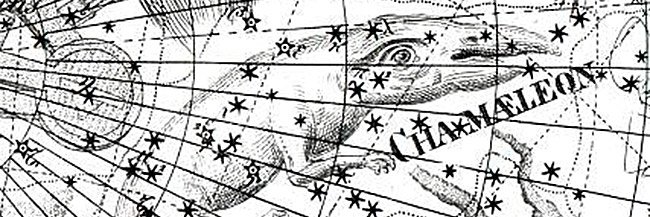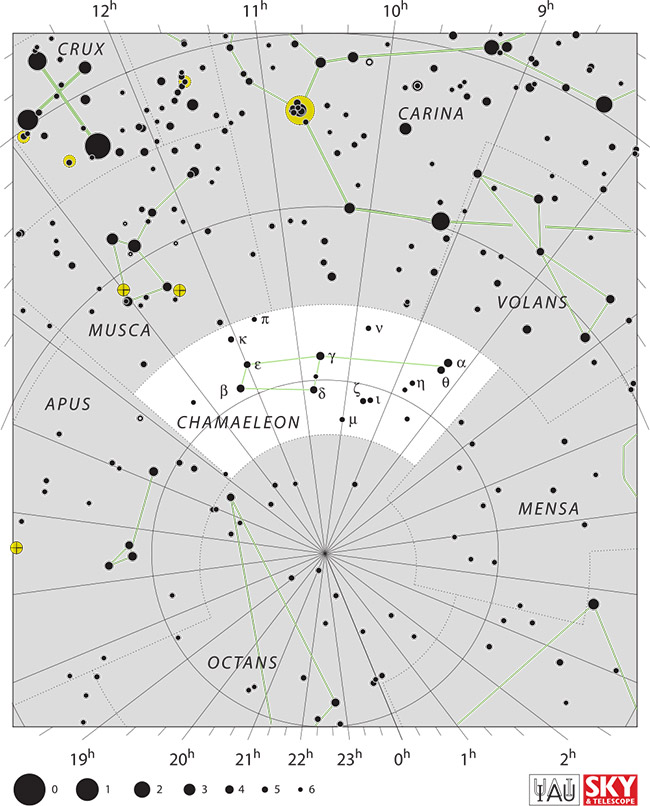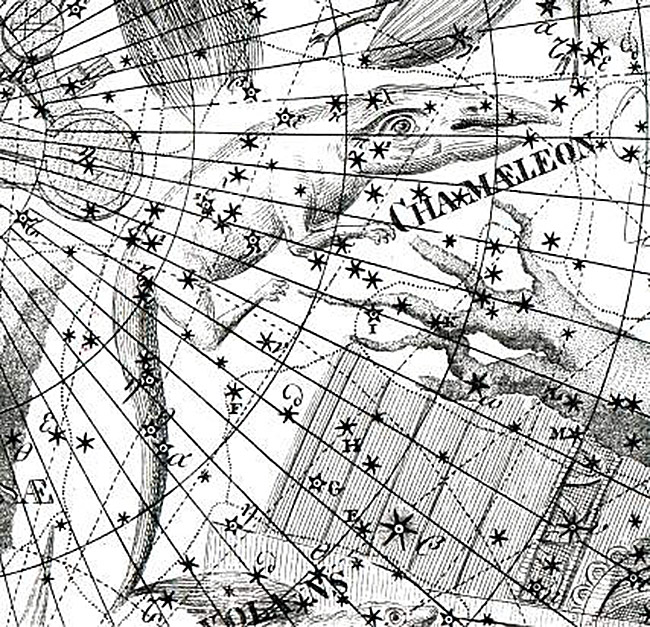Chamaeleon – Constellation Facts

Chamaeleon is a relatively small constellation in the second quadrant of the Southern hemisphere. It can be viewed specifically at latitudes between 0° and -90°. As its name suggests, this constellation is named after a lizard; the chameleon.
Constellation Characteristics
Chamaeleon is 79th in size, covering an area of 139 square degrees. It is neighbors with the constellations of Apus, Carina, Mensa, Musca, Octans and Volans. In addition, Chamaeleon has no Messiers or meteor showers.

IAU and Sky & Telescope magazine (Roger Sinnott & Rick Fienberg), CC BY 3.0, via Wikimedia Commons
By IAU and Sky & Telescope magazine (Roger Sinnott & Rick Fienberg) CC BY 3.0, via Wikimedia CommonsPlanetary Systems
Chamaeleon has three deep sky objects. Read on to discover some fascinating facts about these celestial wonders.
- Eta Chamaeleontis Cluster: also known as Mamajek, this open star cluster is estimated to be around eight million years-of-age. It was only discovered in 1999 and is centered on the star, Eta Chamaeleontis.
- Chamaeleon Cloud Complex: contains a number of molecular clouds, the most notable are; Chamaeleon I (one of the nearest star forming regions with around 200 to 300 stars) Chamaeleon II and Chamaeleon III.
- NGC 3195: this bright planetary nebula cannot be seen from the Northern hemisphere and lies directly between the stars of Delta and Zeta Chamaeleontis.
Main Stars
The constellation Chamaeleon consists of seven main stars that makes up its shape. Let’s explore them further.
- Alpha Chamaeleontis is the brightest star in the Chamaeleon constellation (which will be discussed later in detail).
- Beta Chamaeleontis shines the third brightest in the Chamaeleon constellation and is estimated to be about 270 light-years from Earth.
- Delta-1 Chamaeleontis is a close binary star with two very similar components.
- Epsilon Chamaeleontis is a binary star.
- R Chamaeleontis is a Mira-type variable star with a rotation period of 334 days.
- CT Chamaeleontis is catalogued as a T Tauri star that has a faint companion star known as a brown dwarf.
- HD 63454 can be seen through a small telescope and is located near the South celestial pole, 116.7 light-years away.

Chamaeleon as depicted on Chart XX of the Uranographia of Johann Bode (1801)
Most Shining Star
Out of all the stars that make up the Chamaeleon constellation, none shine brighter than Alpha Chamaeleontis. It is categorized as a spectral type F5 III with an apparent visual magnitude of 4.066. In addition, it is located about 66.5 light-years away.
Mythology & History
Although the Chamaeleon constellation has no mythology surrounding it, it does have a fun story. This constellation (among others) was charted in the 16th century by Dutch navigators. It was then depicted by a Dutch cartography by the name of, Jodocus Hondius, as a chameleon sticking its tongue out trying to capture its neighboring constellation, Musca, “the fly.”
Chamaeleon is a fascinating constellation, so the next time you are gazing into the night sky be sure to search out this intriguing figuration of stars.
